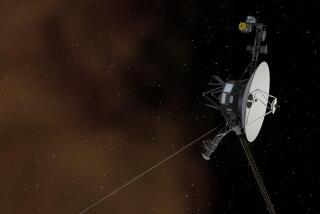Two Probes Wrapping Up Explorations of Venus : Space: Pioneer and Magellan have gone above and beyond in collecting details of the planet. But they are about to fade out.
- Share via
While a new era of missions to Mars is beginning, explorations of our nearest planetary neighbor are coming to a close, at least for the foreseeable future.
Two spacecraft that have collected far more detail than expected about Venus are preparing to send their last rounds of data to Earth.
Pioneer-Venus, launched in 1978--and designed to orbit only for eight months--will plunge into the Venusian atmosphere sometime between October and December and, in the words of one researcher, “die just before it’s cremated.” But the craft will not burn up before sending back new information from the lower atmosphere of Venus that may help reveal whether the planet ever had oceans and whether it has lightning now.
“The fact that Pioneer orbiter is still around is just extraordinary,” said Bruce Murray, who chairs the planetary sciences department at Caltech.
Another satellite, Magellan, ended its mapping mission around Venus on Sunday about 10 p.m. Launched in 1989, it has managed to send back radar images that cover 99% of the surface in great detail--much better than the original goal of mapping 70% of Venus.
Analysis of the most recently mapped region--near highlands in the southern latitudes--is expected to yield images of three or four Venusian volcanoes.
Magellan descends to a lower orbit 113 miles above the surface this week to start its last task, measuring the Venusian gravity field. The National Aeronautics and Space Administration plans to stop operating Magellan’s instruments in May as a cost-cutting measure.
But scientists have made many appeals to the space agency to, as their red lapel buttons say, “Keep Magellan Alive”--at least for another year, to move closer to Venus and fine-tune the gravity information. The craft itself could probably survive for decades, they say. The cost of extending the mission another year is about $28 million.
Both satellites are being managed in California--Pioneer by NASA’s Ames Research Center in Mountain View and Magellan by the Jet Propulsion Laboratory in Pasadena.
Together with Soviet probes in the 1980s, the two spacecraft have compiled a picture of Venus comparable in detail to what is known about Mars. Venus has been much more difficult to investigate because its surface is always obscured by opaque, yellowish clouds, in a goopy atmosphere about 20% as dense as seawater.
Mars and Venus have long intrigued scientists because they are the planets closest and most comparable to Earth. Mars is the planet most likely to have some type of life; Venus is the home of a so-called “runaway greenhouse effect” that could offer clues to our own environment.
But while Mars is the focus for a new string of ambitious ventures by the United States, Russia and Europe, “there is an end game going on here” with Venus, said Gordon Pettengill, professor of planetary physics at Massachusetts Institute of Technology. Pettengill supervised radar mapping for both Pioneer and Magellan.
That does not mean no new surprises will emerge. The latest data from the two U.S. craft should keep scientists busy “for a decade or so, studying these beautiful images,” Pettengill said. “There are some mysteries left and someone will begin to piece it together.”
Even before that, he said, the lobbying for more Venus missions will be well under way. Landers that actually touch down--as Viking did on Mars--could monitor seismic activity and provide much insight into the planet’s inner workings, he said.
There is just one problem: There are currently no landers that could survive for more than an hour on Venus, where the surface temperature could melt lead. That doesn’t phase Pettengill. “There are developments coming along,” he said.






